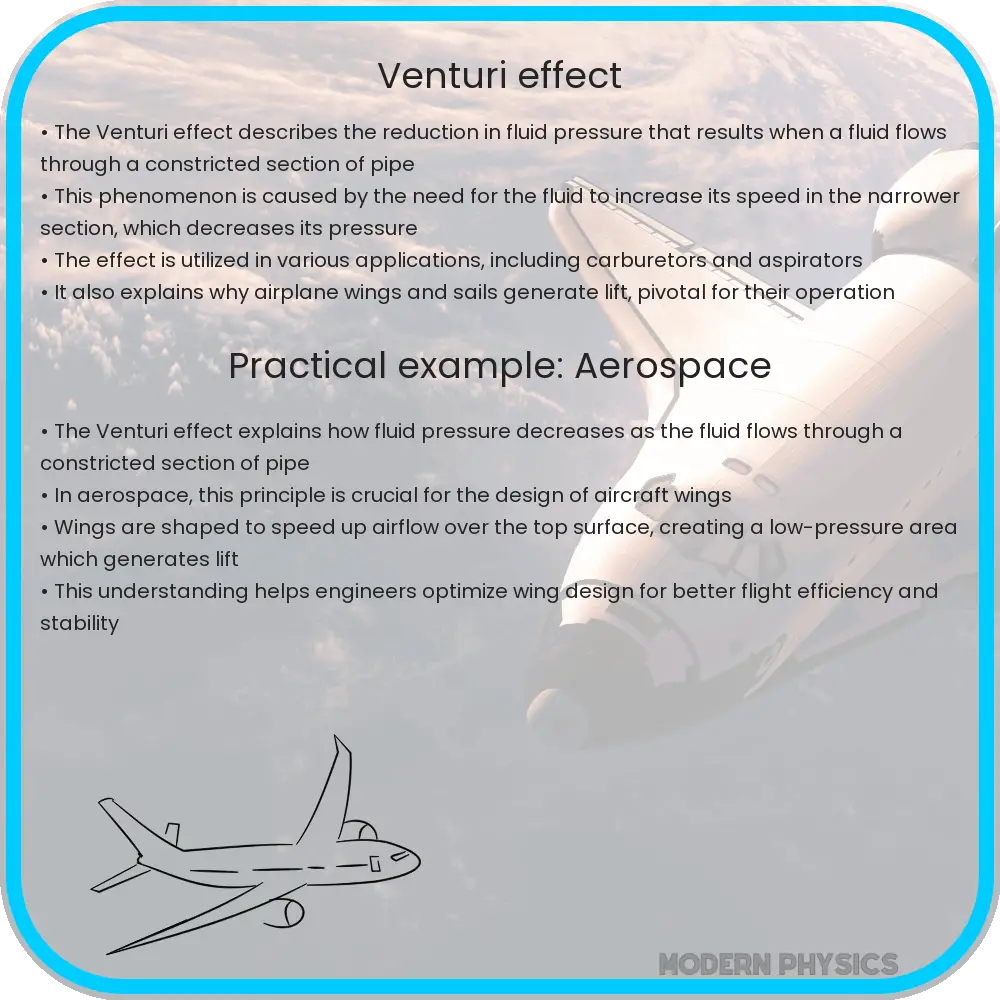Explore the Venturi Effect: Unveiling principles, diverse applications, and in-depth analysis in fluid dynamics and technology.

Understanding the Venturi Effect
The Venturi Effect is a fundamental principle in fluid dynamics, observed when a fluid flows through a constricted section of a pipe or channel. This phenomenon is named after Giovanni Battista Venturi, an 18th-century Italian physicist, who first described the relationship between the velocity and pressure of fluids in motion.
Principles of the Venturi Effect
At the core of the Venturi Effect is Bernoulli’s principle, which states that an increase in the speed of a fluid occurs simultaneously with a decrease in the fluid’s potential energy. The principle can be expressed mathematically as:
\[ P + \frac{1}{2}\rho v^2 + \rho gh = \text{constant} \]
Where:
- P is the fluid pressure,
- \(\rho\) is the fluid density,
- v is the fluid velocity,
- g is the acceleration due to gravity, and
- h is the height above a reference point.
In the Venturi Effect, as the fluid enters a constricted section of a tube, its velocity increases, leading to a corresponding drop in pressure. This relationship is crucial for various applications in science and industry.
Applications of the Venturi Effect
The Venturi Effect finds its use in numerous practical applications:
- Fluid flow measurement: Devices like the Venturi meter are used to measure the flow rate in pipes, based on the change in pressure across a constricted section.
- Carburetors: In automotive engineering, carburetors utilize this effect to mix air and fuel in an internal combustion engine.
- Aerodynamics: The effect is also evident in aerodynamics, where it helps in understanding airflow over wings and through turbines.
- Medical devices: Certain respiratory devices and nebulizers use the Venturi Effect for efficient delivery of medication.
Each of these applications leverages the unique relationship between velocity and pressure in flowing fluids, as outlined by the Venturi Effect.
Analysis of the Venturi Effect
Analyzing the Venturi Effect involves understanding the fluid’s behavior as it moves through different cross-sectional areas. This analysis often involves complex calculations and considerations of factors like fluid viscosity, temperature, and the physical properties of the conduit.
Detailed Analysis in Practical Scenarios
The analysis of the Venturi Effect in real-world scenarios requires consideration of various additional factors. For instance, in real fluids, viscosity plays a significant role. It can cause energy losses, especially in the constricted section of the pipe, slightly modifying the ideal predictions of the Venturi Effect. Temperature variations can also affect fluid density, further influencing the flow dynamics. Engineers and scientists often use computational fluid dynamics (CFD) simulations to accurately predict and analyze these scenarios.
Challenges and Limitations
While the Venturi Effect is immensely useful, it also presents certain challenges. In industrial applications, for instance, the presence of impurities or particulate matter in fluids can lead to inaccuracies in flow measurements using Venturi meters. Additionally, the design of the constricted section must be precise; any miscalculation can significantly affect the outcome and efficiency of the process or device relying on the Venturi Effect.
Innovations and Future Prospects
Recent advancements in technology have led to innovative applications of the Venturi Effect. In environmental engineering, it is used in pollution control devices to remove particulates from industrial emissions. The principle is also being explored in renewable energy technologies, such as wind turbines and hydroelectric systems, to enhance efficiency. Ongoing research is focused on optimizing designs and materials to overcome the current limitations and expand the applications of the Venturi Effect.
Conclusion
The Venturi Effect is a pivotal concept in fluid dynamics with a wide array of applications across various fields. From its fundamental principles rooted in Bernoulli’s equation to its practical applications in measuring fluid flow, automotive engineering, aerodynamics, and medical devices, it demonstrates the profound impact of fundamental physics on technology and industry. Despite certain challenges and limitations, continuous innovations and advancements promise to further expand its utility in future applications. Understanding and harnessing the Venturi Effect remains an essential aspect of engineering and scientific endeavors, providing solutions to complex problems and contributing to technological progress.
